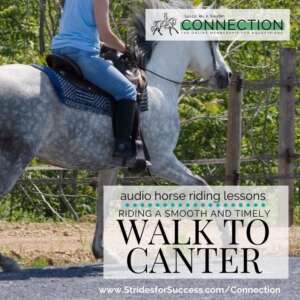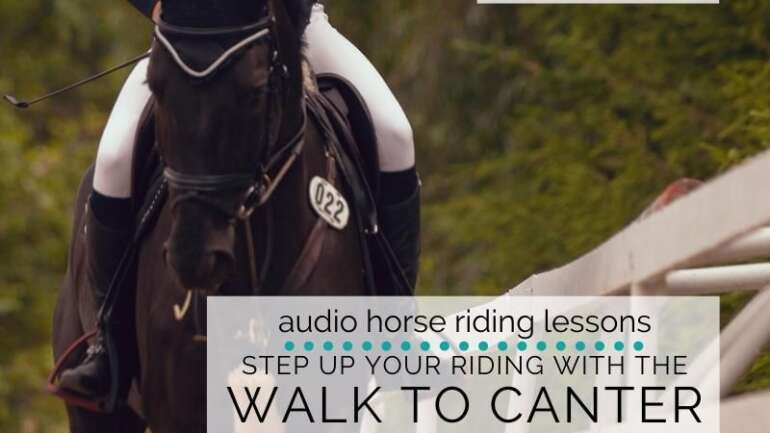This transition is a personal favorite of mine. To ride and to help other riders as well. I really do believe that the walk to canter transition can help you and your horse to connect more to each other. It can help you to have more clarity over your canter aids, and your horse to become more responsive. And you both to develop so that your training can progress forward.
In fact, the walk to canter can help horses and riders progress in ways that they don’t even realize they are. It introduces a certain level of collection to the ride. For many riders, this is one of the best introductions to this as it feels very natural and ‘in flow’.
You can begin introducing, or refining, the existing transition from the walk to canter today in your training by focusing on a few different elements.
Your Canter Aids
One of the reasons the walk to canter transition is so good for riders is due to the speed of the walk. Many riders can feel flustered, bounced, rushed, or tense when preparing for and riding the trot to canter transition. Which is one of the reasons I love helping riders to effectively use the walk to canter transition in their training.
The walk to canter transition allows riders enough time and space to identify the point in the stride to ask for the transition, as well as actually apply their aids in a meaningful and effective way.
I have an article and Daily Strides Podcast episode HERE that details the aids to ask for the canter that you might find useful for your riding.
Timing Your Aids to Ask for Canter
One of the biggest challenges riders have when it comes to getting into a canter with their horse is timing. When you ask the question makes a huge difference to how your horse responds. If we ask at a point in the stride where he simply can’t respond, this can lead to excess tension, rushing, or just being ignored!
When using the transition from walk to canter to really work on the timing of their ‘ask’ for the canter, it allows both horse and rider to begin riding cleaner transitions
I would suggest spending some time on the walk familiarising yourself with what is moving where underneath you. When you feel your right seatbone swing down and forwards, it means that your horse’s right back leg is also moving forwards. As this is happening, your left seatbone will have moved up and is ‘moving backward’. This is because your horse’s left back leg is, at this moment, on the ground. His body is moving over the back leg, creating the ‘up’ feeling through your seatbone.
You will ask for the canter as the outside back leg is moving forward and preparing to step down into the stride. This will allow this leg to become the 1 in the 1,2,3 that makes up a canter stride.
I have another article and an episode of the Daily Strides Podcast HERE that goes into much more detail when it comes to timing your aids to ask for the canter.
Increasing Responsiveness
So often, we make the mistake of assuming this is a horse issue. ‘My horse is not responsive enough’ is a common complaint among riders! I truly think this has more to do with you first. And when you begin to become more responsive and intentional, your horse will respond by improving how well he listens.
Begin building responsiveness by becoming very focused on what you want to make happen, when you want it to happen, and where you want it to happen – and stick to those decisions.
A great exercise you can use to help you work on increasing responsiveness is to ride set numbers of strides in each gait. So, for example, 10 strides of walk followed by 10 strides of trot. Then back to 10 strides of walk again. As you and your horse improve the communication between you both, begin playing with the number of strides between each transition.
The more responsive you both become, the easier you will find it to ride fewer strides in each gait while still maintaining your relaxation, balance, and suppleness.
This is when you know that you and your horse are on the same page, listening to each other, and ready to ‘step up’ into the canter from the walk. I have a previous article and episode of the Daily Strides Podcast HERE that will help you to improve your responsiveness in your riding.
Riding the Walk to Canter Transition
Once you and your horse are clear on the aids, clear on the timing, and responsive towards each other, you can prepare to ask for the walk to canter transition. Start by focusing. on the rhythm of the walk, the energy inside of the walk, and the flexion.
From here use your half halt to firstly get your horse’s attention, and then, from there, to gather and channel the energy a little more inside of the walk
This will feel like a slight collection and your horse will need this in order to successfully make the transition from walk to canter. Your job in all of this is to set things up and then allow your horse to actually perform the transition. So many riders think it is their job to canter. It’s not. Make sure you engage your core, work on your posture, and allow your horse to simply ‘step into’ the new gait when you ask.
I have a previous article and episode of the Daily Strides Podcast HERE on how important your posture is to a successful transition into the canter.
From here, it is simply a matter of ‘asking’ and then allowing your horse to respond.
Happy Riding
Lorna
Riding a Smooth & Timely Walk to Canter Transition
Some exercises can have a ripple effect all through our riding when we dedicate some time and energy to making them better. I believe that the walk to canter is one of those exercises and I am excited to help you master the transition this month with your horse.
This group of episodes is available for you to begin working with today, inside of Connection. They are suitable for all horses and riders who are able to canter. They will help you both become clearer on the aids, and more focused on timing and its importance. And more balanced and responsive as well.


